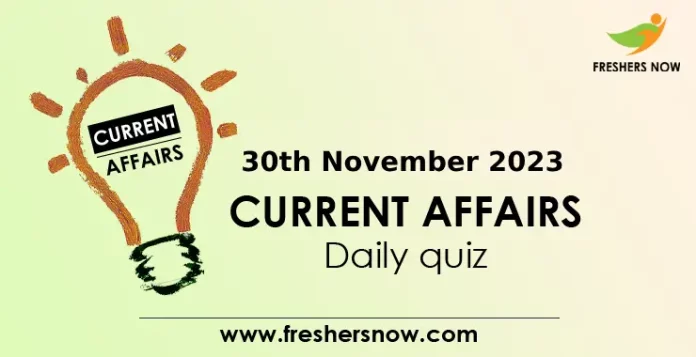
30th November 2023 Current Affairs Quiz: To test your awareness and understanding of these current affairs, we present the “30th November 2023 Current Affairs Quiz.” This quiz aims to challenge your knowledge of key happenings across various domains, including politics, technology, environment, and more. Stay informed and engage with the dynamic events that unfolded on this date by participating in this quiz. It’s an opportunity to stay connected with the world’s pulse and evaluate your comprehension of the latest news and noteworthy occurrences. Join us in exploring and assessing the impactful events that unfolded on 30th November 2023.
30th November 2023 Current Affairs | Today GK Quiz
1. What is the main objective of Adani Power Ltd’s green ammonia combustion pilot project at the Mundra power plant?
A. To increase coal consumption
B. To simulate combustion tests in Japan
C. To reduce carbon footprint and adopt sustainable practices
D. To promote traditional fossil fuel usage
Answer: C. To reduce carbon footprint and adopt sustainable practices
Explanation: The main objective of the pilot project is to align with Adani Power’s commitment to adopting sustainable practices and reducing its carbon footprint by co-firing green ammonia, derived from green hydrogen, with conventional coal in the Mundra power plant’s boiler.
2. Which Japanese companies have collaborated with Adani Power for the green ammonia combustion pilot project?
A. Mitsubishi and Sony
B. IHI and Kowa
C. Toyota and Panasonic
D. Honda and Toshiba
Answer: B. IHI and Kowa
Explanation: Adani Power has formed strategic partnerships with IHI and Kowa, both prominent Japanese companies. IHI specializes in ammonia firing technology, while Kowa is known for energy-saving and energy-creating products, contributing valuable expertise to the initiative.
3. What is the primary purpose of upgrading the Kavach anti-collision system to 4G/5G (LTE-based) technology?
A. To increase the speed of trains
B. To improve railway aesthetics
C. To enhance railway safety and prevent collisions
D. To reduce the cost of railway operations
Answer: C. To enhance railway safety and prevent collisions
Explanation: The main objective of upgrading the Kavach system to 4G/5G technology is to enhance railway safety by preventing collisions through the use of Automatic Train Protection (ATP) technology.
4. What advantage does Kavach offer over its European counterparts, making it cost-efficient?
A. Advanced entertainment features
B. Lower installation capacity
C. Costing Rs 40-50 lakh per kilometer
D. Compatibility with outdated technology
Answer: C. Costing Rs 40-50 lakh per kilometer
Explanation: Kavach is considered cost-efficient as it is priced at Rs 40-50 lakh per kilometer, making it 25-33% more economical than its European counterparts. This cost efficiency is highlighted as one of its key advantages in the context of railway safety and collision prevention.
5. What is the purpose of the Reserve Bank of India’s ‘Alert List’ update?
A. To promote forex trading activities
B. To identify authorized entities for forex transactions
C. To safeguard investors by listing unauthorized forex trading platforms
D. To encourage financial risks for consumers
Answer: C. To safeguard investors by listing unauthorized forex trading platforms
Explanation: The update of the ‘Alert List’ by the RBI aims to safeguard the interests of investors by including unauthorized forex trading platforms. This measure is taken to curb illegal forex trading activities and protect consumers from potential financial risks.
6. How many entities have been added in the latest update of the ‘Alert List’ by the Reserve Bank of India?
A. 50
B. 19
C. 75
D. 1999
Answer: B. 19
Explanation: The latest update of the ‘Alert List’ includes 19 additional entities, bringing the total number to 75. This update reflects the RBI’s continuous efforts to combat illegal forex trading activities and enhance investor protection.
7. According to the World Economic Forum (WEF) report, what is the estimated amount of investments required by 2050 for transitioning to a sustainable and carbon-neutral future?
A. USD 5 trillion
B. USD 13.5 trillion
C. USD 20 trillion
D. USD 1 billion
Answer: B. USD 13.5 trillion
Explanation: The WEF report emphasizes the need for USD 13.5 trillion in investments by 2050 to transition to a sustainable and carbon-neutral future, with a focus on key sectors like production, energy, and transport.
8. Which countries are mentioned as major producing countries in the context of committing to net-zero targets in the report?
A. Brazil and Russia
B. India and China
C. Australia and Japan
D. Canada and Mexico
Answer: B. India and China
Explanation: The report mentions major producing countries, including India and China, along with the US and the EU, that have committed to net-zero targets. This commitment necessitates businesses aligning their operations with evolving regulatory landscapes in these regions.
9. When did Nepal’s Supreme Court issue an interim order legalizing same-sex marriage?
A. June 27, 2023
B. 2007
C. Four months ago
D. 2015
Answer: A. June 27, 2023
Explanation: The Supreme Court of Nepal issued an interim order on June 27, 2023, temporarily legalizing same-sex marriage, marking a significant step toward the official recognition of LGBTQ+ rights in Nepal.
10. Which district in Western Nepal witnessed the first formally recognized same-sex marriage?
A. Nawalparasi
B. Dordi
C. Lamjung
D. Kathmandu
Answer: C. Lamjung
Explanation: The first formally recognized same-sex marriage took place in the Dordi Rural Municipality of Lamjung district in Western Nepal, where the union of trans-woman Maya Gurung and gay man Surendra Pandey was legally recognized.
★★ You Can Also Check ★★



